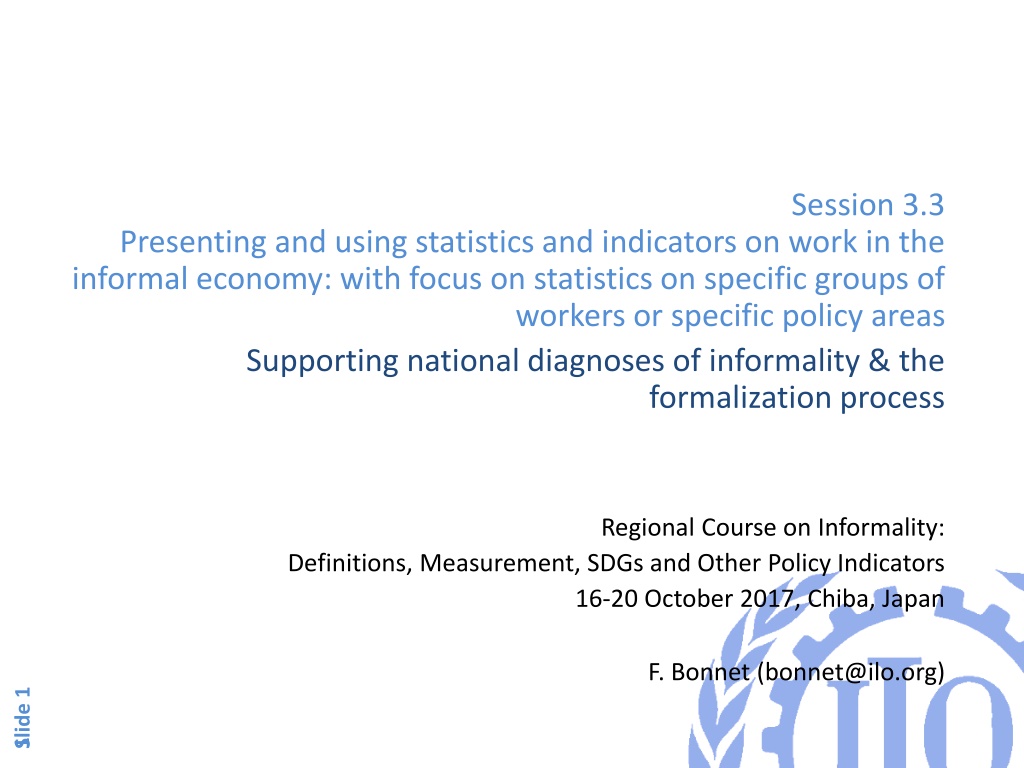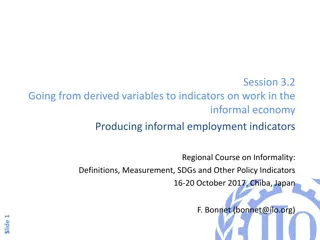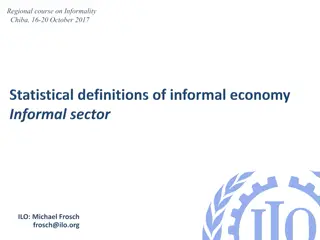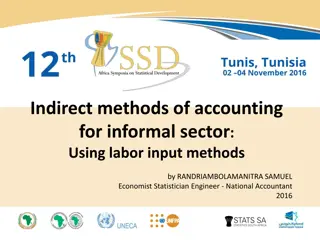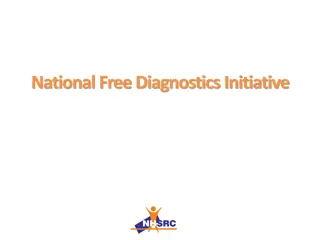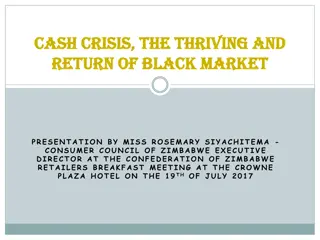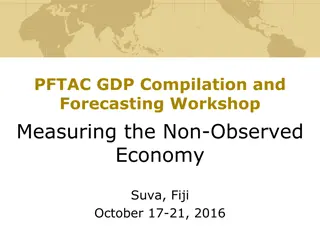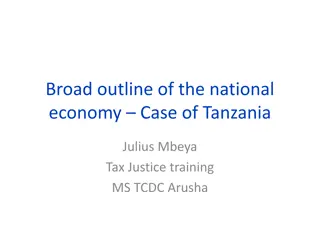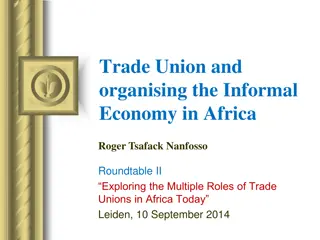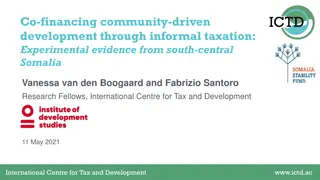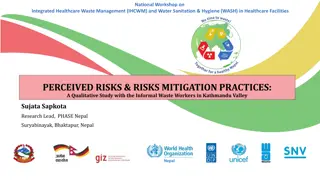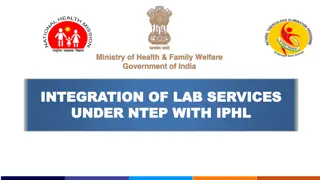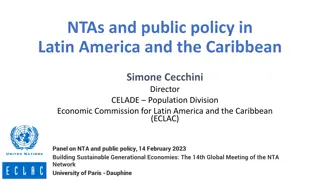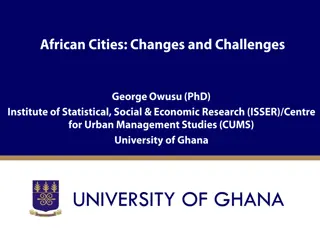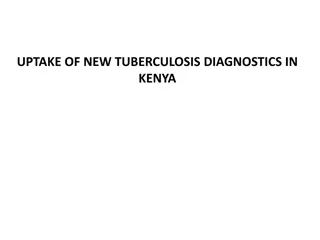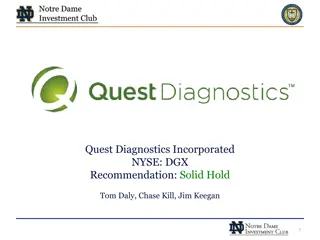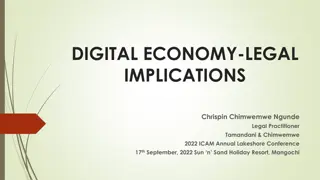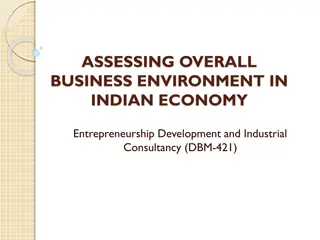National Diagnostics of Informality in the Informal Economy
This session focuses on presenting and using statistics and indicators on work in the informal economy, with a specific emphasis on specific groups of workers and policy areas. It covers aspects such as national diagnoses of informality, the formalization process, assessing drivers of informality, and working conditions among workers in informal employment. Recommendations from Recommendation 204 are discussed, highlighting the importance of data and statistics in identifying the nature and extent of the informal economy.
Download Presentation

Please find below an Image/Link to download the presentation.
The content on the website is provided AS IS for your information and personal use only. It may not be sold, licensed, or shared on other websites without obtaining consent from the author. Download presentation by click this link. If you encounter any issues during the download, it is possible that the publisher has removed the file from their server.
E N D
Presentation Transcript
Objective of the session Session 3.3 Presenting and using statistics and indicators on work in the informal economy: with focus on statistics on specific groups of workers or specific policy areas Supporting national diagnoses of informality & the formalization process Regional Course on Informality: Definitions, Measurement, SDGs and Other Policy Indicators 16-20 October 2017, Chiba, Japan F. Bonnet (bonnet@ilo.org) Slide 1 1
2 Content 1. Reminder - what recommendation 204 says about national diagnostics (& statistics) National diagnostics of informality: Overview of main steps of the diagnostic & statistics as part of it Additional indicators as part of national diagnoses: o Assess some of the drivers of informality (those that can be quantified) and working conditions among workers in informal employment Group work: a case study and 3 groups Employees in informal employment Independent workers Agriculture 2. 3. 4. Slide 2 2
3 Content 1. Reminder - what recommendation 204 says about national diagnostics (& statistics) Slide 3
0. Introduction 0. Introduction R204 calling for a diagnostic R204 calls for data and statistics to identify the nature and extent of the informal economy (I Objectives and scope [para 6]). This represents a first significant step as part of national diagnoses . 6. . given the diversity of the informal economy across member States, the competent authority should identify the nature and extent of the informal economy as described in this Recommendation, and its relationship to the formal economy. 8. Members should undertake a proper assessment and diagnostics of factors, characteristics, causes and circumstances of informality in the national context to inform the design and implementation of laws and regulations, policies and other measures aiming to facilitate the transition to the formal economy. Who are the workers in the informal economy? Analysis of some of the main drivers of informality => Not all quantifiable o Build consensus about national priorities o Basis for the adoption, review and enforcement of national laws and regulations to ensure appropriate coverage and protection of all categories of workers and economic units Slide 4 4
5 Content 2. National diagnostic of informality What is it about? & What is it for? A word about the drivers of informality, including those that can be quantified Slide 5 LSI Measuring and Monitoring informality
2. National diagnostics of informality: what and what for? The diagnostic: What? & What is it for? The starting point for a better understanding of the informal economy and the context o Level, nature, characteristics of workers and economic units in the informal economy o Main drivers of informality and obstacles to formalisation o Mapping and assessment of current policies/ measures A sequence of steps: still not strict and allowing for back and forth A broad range of issues to be covered Some quantitative and qualitative elements to inform all actors involved; A comprehensive / inclusive process to build a large domestic consensus about this diagnostic among main actors: governments, social partners, etc. Some tools to support specific steps Either comprehensive for the economy as a whole or focused To decide on priorities and discuss on the policies design Slide 6 6
2. Overview of main steps & possible sequence of the diagnosis 2. Identify national priorities, Overall policy framework (first step) 1. Quantify the extent and qualify the nature of the informal economy Participative process & tripartite mechanisms 3. Identify main actors involved; vision(s) of the informal eco & coordination mechanisms if any DIAGNOSTIC Complemented by a broader assessment of the labour market & macro economic situation Option 1 Identify the categories of workers and enterprises or sectors warranting priority action and engage in next steps of the diagnosis focused on those groups Option 2 Continue the process without setting priorities at this stage but after 5. 4. Identify the main drivers of informality & incentives for formalization 5. Identify and assess current policy approach, specific measures and impacts 6. Identify priority measures and sequencing to facilitating the transition from informal to formal 7. Provide a set of policy recommendations & a sequencing to formulate the road map Slide 7 7
2. Main drivers of informality macro level to micro level drivers 1) Macro economic context Inability of the economy to create enough formal jobs 3) Micro level determinants Low educated and qualified workforce => low mobility from informal to formal jobs The macro-economic context Economic crisis and economic restructuring Discrimination (exclusion of workers from categories of jobs based on race, gender, age) Flexibilization of formal jobs as a result of globalization pressures Multiples drivers and incentives of informality Regulatory framework inadequate or lacking instit. & enforcement mechanisms 2) Regulatory framework, public Poverty Inability to overcome costs of formalization Low Lack of transparency & accountability of public institutions => lack of trust productivity Lack of communication => lack of awareness Lack of access to market; finances; technology 4) Attractiveness of informal activities (evasion of tax/ contributions, work family balance) Weak enforcement systems, incl. labour inspection Lack of adequate social benefits to secure income / inappropriate modalities to comply Lack of voice and representation of workers Slide 8
3. Additional indicators as part of a broader diagnostic of informality Identify the main drivers of informality & incentives for formalization (focus on those that can be quantified) Slide 9
3. Indicators Additional data item subject to data availability For persons in informal employment in and outside the informal sector: Exposure to decent work deficits & some of the drivers of informality o Levels of education and access to training/ retraining o Level & regularity & predictability of income from labour o Type and duration of contract (employment security) o Representation of workers o Access to credit & economic resources o Hours of work outside normal hours (short hours or exposure to long hours without due compensation) o Health and safety issues o Lack of social security gained trough employment o . and coverage by non-employment related social protection otherwise o Poverty as cause or a consequence of informality (usually not covered in labour force survey) The depth of analysis will depend on the available information in the survey! Can typically be part of labour force surveys Part of household income and expenditure surveys => supposes the inclusion of appropriate questions to identify workers in informal employment Slide 10
3. Assessing possible drivers of informality Level of education, access to training & retraining & informality Questions? o The level of education is maybe not a guarantee to access formal employment but is it an asset? Do people in informal employment have the same opportunities than formal workers to access training and re-training when needed? Is there particular training needs? What about the supply side: What exist? Does this match with labour market needs? Is there a need for developments? In which domain? According to what modalities? Who will pay for it? Indicators o o o o Share of informal employment by level of education (by sex, status in employment; sectors; occupations) o Distribution of workers in informal employment by level of education (compared to the similar distribution among workers in formal employment) => is there a real deficit of education/ qualifications in the informal economy? Slide 11
2. Low levels of education as a driver of informality? % informal employment and highest level of education % informal employment by highest level of education Common trends: Decrease in informality rates with the increase in the level of education: the level of education of workers is not a guarantee but an important asset to access formal employment. Note: regional estimates based on more than 60 developing countries (representing nearly 80% of total population in the developing world) Source: ILO calculations based on national household surveys. Slide 12
2. Low levels of education as a driver of informality? Distribution of workers in informal (or formal employment) by level of education: Selected Asian countries Myanmar Viet Nam Indonesia Samoa Slide 13
4. Informality and decent work deficits Access to training and promotion (Mali & Benin) Promoted over the last few years (% employees) Access to training (% employees) Slide 14 Source: ILO calculations based on EPAM dataset, 2010 & EMICOV Benin 2011
3. Assessing possible drivers of informality & exposure to decent work deficits Assess levels, regularity & predictability of income from labour in the informal economy (income security) Questions? o Labour income: compare levels, predictability and stability of incomes for workers in informal employment compared to those in formal employment o Wages for employees in informal employment compared to those in formal employment (levels and type and remuneration) o Labour income from independent work in informal sector units compared to those in the formal sector Do levels and regularity of incomes from labour fit with the cost of formalization (registration, taxes, contributions to social security) and modalities to comply? Broader assessment of working poverty and informality Indicators o Among employees: Average wage among employees in informal employment (in the informal sector/ in the formal sector/ in households) compared to those in formal employment (by sex, sectors, occupation, level of education) o Among independent workers: level of profit? o Form of remuneration as an indicator of stability and predictability of income o o Slide 15
Informality and monthly earnings among employee examples from Viet Nam By sex By sector By level of education By occupation Source: ILO calculations based on LFS Viet Nam 2014 Notes: Activities - 5 - Market Services include Trade; Transportation; Accommodation and food; and Business and administrative services) and 6 - Non-market services include Public administration; Community, social and other services and activities Slide 16
3.2 Informality and method of remuneration among employees lower level of predictability & regularity of incomes among employees in informal employment Among employees Slide 17 Source: ILO calculations based on Cameroon ECAM7, LFS VietNam 2015; LFS Indonesia 2016; India LFS 2012; Bangladesh LFS 2013
Relative poverty rates in selected European countries 3. Informality and poverty 3. Formal and informal employment & poverty rate Slide 18 Source: ILO calculations based on national household surveys Note: Selected non European countries with Poverty line of $PPP 3.10 per capita per day in line with the latest extreme or moderate international poverty line. Relative poverty line for European countries (60% median value of household disposable income)
3. Assessing possible drivers of informality & exposure to decent work deficits Focus on the particular case of employees Existence, type and duration of contract (employment insecurity) Questions? o o Are people on temporary contract more exposed than others to informality? Are people in the informal sector more likely to be on non-permanent type of contract? Is there a need to adjust the legislation (too heavy, inappropriate) to promote the effective contractualization of the employment relationship? Are the same levels of protection (labour and social protection) attached to temporary contracts compared to permanent contract? Indicators o o Among employees: % informal employment among employees under a temporary contract compared to employees under a permanent contract o % employees contributing to social security depending on the existence and the type of contract Slide 19 o Note: to be complemented by the assessment of social security and labour laws
3. Informality and type of contract (among employees) Share of informal employment given the type of contract Among employees Slide 20 Source: ILO calculation, harmonized definition of informal employment and informal sector. Global and regional estimates based on data for 96 countries representing over 78% of the world working population
3. Informality and type of contract (among employees) Share of formal and informal employment in non-standard forms of employment compared to Full-time permanent employment Examples from selected Asian countries Indonesia Among employees Brunei China India Viet Nam Lao, PDR Slide 21 Source: ILO calculation, harmonized definition of informal employment and informal sector. Global and regional estimates based on data for 96 countries representing over 78% of the world working population
3. Assessing possible drivers of informality & exposure to decent work deficits Working hours and informality Questions? o Being outside the scope of labour law, do people in informal employment tend to be over-represented outside normal hours of work o Do people in informal employment work less than 35 hours? Why and would they like to work more? Does this result in poor incomes and poverty? o By contrast do they work excessive hours without due compensation but the exposure to health and safety risks? Indicators o Incidence of very short hours of work among workers in informal employment compared to those in formal employment (by sex, status in employment, occupations) o Is this by choice or a lack of opportunity for more hours? Assess time related under-employment and informality o Incidence of excessive hours among workers in informal employment compared to workers in formal employment (by sex, status in employment, occupations) Slide 22
3. Informality and Working time Workers in informal employment are more likely to stand outside normal hours of work as they stand outside of labour law protection Higher proportions of workers in informal employment working less than 20 hours a week, especially among women Very short hours (<20h) Source: ILO calculations based on national household surveys. Notes: Global & regional estimates based on 106 countries representing 88% of global employment. Slide 23
4. Informality and short hours of work . Often associated with time related underemployment Slide 24 Source: ILO calculations based on national household surveys. Note: time related under-employement for those working less than 35 hours a week
3. Informality and Working time Workers in informal employment are more likely to stand outside normal hours of work as they stand outside of labour law protection . at the same time, higher proportions of workers in informal employment working more than 48 hours a week, especially among employees Excessive hours (>48h) Source: ILO calculations based on national household surveys. Notes: Global & regional estimates based on 106 countries representing 88% of global employment. Slide 25
3. Assessing possible drivers of informality & exposure to decent work deficits Informality and health and safety issues Questions? o Are workers in informal employment, in informal sector enterprises, more exposed to health and safety risks? Assessment of the gaps in both prevention and protection measures Is there a need for specific measures and what measures o At the workplace o At the level of labour inspection and other responsible services o o Indicators o Exposure to hazardous conditions of work for respectively workers in formal and informal employment or in formal sector and informal sector units (by sex, status in employment, sectors, occupations) o Use of preventive equipment o Incidence of occupational injuries and diseases o Protection in case of need (health and employment injury insurance) Note: to be complemented with qualitative information about coverage by existing scheme (who is covered, what modalities and for what benefits) Slide 26
and higher exposure to hazardous working conditions (Bangladesh & Pakistan) Bangladesh | Exposure to hazardous working conditions (total employment) Tanzania | % employment that had injury and/or illness at work Slide 27 Source: ILO calculations based Bangladesh LFS 2013 and LFS Tanzania 2014
3. Assessing possible drivers of informality & exposure to decent work deficits Representation of workers in the informal economy Questions? o What are the forms of representation of workers in the IE? o in LFS can find a question about trade unions, usually asked to employees) o In enterprise surveys may find other forms of representation and associations What could be the role of workers and employers organization in the formalization process o Current services and expectations from members o May call for specific surveys and more qualitative assessments Indicators o o Share of employees affiliated to a union; Share of workers affiliation to any type of professional organization Slide 28
3. Informality and trade union membership Trade union membership: comparison between employees in informal employment and employees in formal employment (exploratory work) Among employees Slide 29 Source: ILO calculations based on national household surveys Source: ILO calculations based on national household surveys (harmonized definition)
4. Group work Slide 30
4. Case study Statistics on the informal economy as a basis for the definition of policies Several Government representatives and social partners from Abelina, were actively involved in the discussion and adoption of the Recommendation 204 at the ILC in June 2015. They came back from Geneva with the firm intention to quantify the extent of the informal economy but also to quantify and quality its composition, including workers and economic units most affected by informal employment. Soon after their return they call a first meeting with Mr. Oscope, director of the National Statistical Office of Abelina to get a first overview of what is available or otherwise what could be implemented in the short run and further developed later. According to Mr. Oscope, based on the annual integrated labour force survey, in 2015, only the employment in the informal sector was estimated based on the registration of enterprises or formal bookkeeping. Since then, Mr Oscope and other members of the NSO participated in trainings (including in Chiba), included the necessary questions to assess both informal employment and employment in the informal sector in line with international standards, collected the necessary data (the first round was available in 2016) and are now in a position to provide useful facts to the relevant ministries in charge of formalization and other actors actively involved in those issues (workers and employers organisations) Slide 31
4. Case study A participative process of discussion started earlier this year (2017) to discuss a possible focus on 3 particular groups of workers in the informal economy Group 1: Employees in informal employment Group 2: Entrepreneurs of small and micro enterprises (own-account workers and employers) Group 3: Workers in agriculture Slide 32
4. Case study A rapid diagnostic of the situation have been carried out so far but more needs to be done Based on the first set of results, the group in charge of the implementation of R204 would like you to: Question 1 Identify what seems to be some of the main causes of informality for specific group of workers you are considering the quantitative facts that are available (providing elements about micro level determinants of informality) the qualitative assessment of other issues related to the legal and regulatory framework, the business environment or the representation of workers as relevant Question 2 Identify and discuss what decent work deficits they are facing: they call for appropriate responses Question 3 How could we complement this diagnostic with additional facts to be in a better position to define priorities and support the development of appropriate measures Slide 33 Issues to be covered, data to be collected and most appropriate source and method
